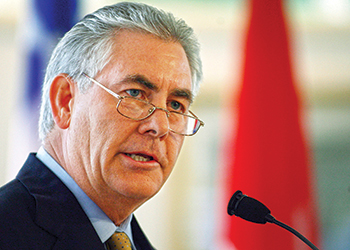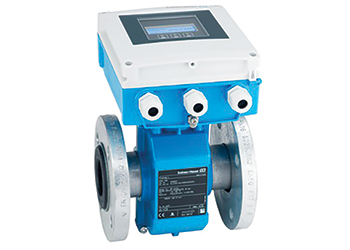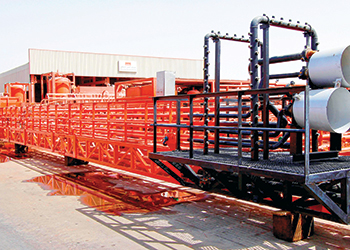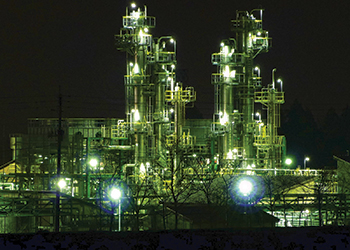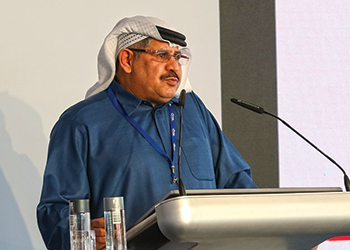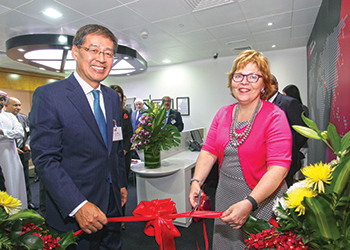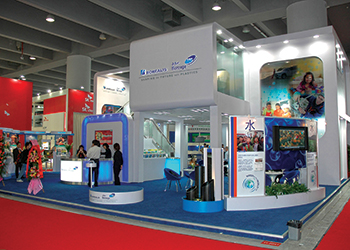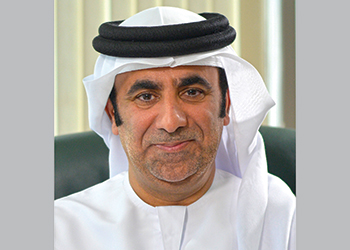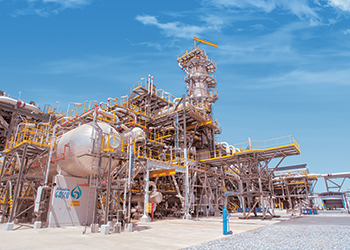
 Adnoc ... aggressive response to oil price crash
Adnoc ... aggressive response to oil price crash
Rather than scrap major projects, Adnoc is seeking to streamline and optimize field development and take advantage of market conditions through greater pressure on subcontractors to provide more competitive costings on key schemes
Abu Dhabi has unveiled ambitious plans to ramp up oil output to 3.5 million barrels per day (mbpd) from the current 2.7 mbpd with investments of $25 billion over the next five years, despite the current downturn.
The increase will come from the Abu Dhabi National Oil Company’s (Adnoc) push in onshore operations and increasingly in offshore developments.
Rather than scrap major projects, Adnoc is seeking to streamline and optimise field development and take advantage of market conditions through greater pressure on subcontractors to provide more competitive costings on key schemes.
Delays are already being seen in some major developments by the other state-owned oil firm, Abu Dhabi Company for Onshore Operations (Adco), which is reported to have pushed back a decision to move forward on the estimated $3 billion Bab integrated facilities project by more than three months. That project is designed to install new facilities at Adco’s Bab field, 160 km south-west of Abu Dhabi city.
The 25 per cent cuts would put Adnoc in line with recent spending curbs by international oil companies. It also fits with a shift towards greater fiscal conservatism in the Gulf Co-operation Council. The UAE announced a federal budget for 2016 of Dh48 billion ($13 billion) in late October, 1.1 per cent lower than the budget approved for 2015 (although this covers only a minority of total UAE government expenditure, with the bulk of spending concentrated at emirate level).
Al Dhafra Petroleum, 60 per cent owned by Adnoc and 40 per cent owned by Korea National Oil Corp and GS Energy Group, is aiming to become the first onshore and offshore producer of oil in Abu Dhabi by bringing three hub fields onstream over the coming years.
The company will start production from the Area 1 and Area 2 fields onshore before tapping the offshore Area 3.
In Area 1, which lies in southeast Abu Dhabi on the border with Oman, Al Dhafra is targeting the Haliba Field which was originally discovered in the 1990s when two wells were drilled.
New seismic was acquired over the field in 2014 and five appraisal wells have been drilled in the past two years. First oil from Haliba is planned in fourth-quarter 2017, with production ramping up to a peak of 30 mbpd. Al Dhafra will also continue exploring in the area and will look to develop the Bu Qalla and Riqeah fields north of Haliba to maintain production beyond 2026.
Development of Area 2—located in southwest Abu Dhabi on the border with Saudi Arabia and where six wells were originally drilled from 1960-1970—will follow. Al Dhafra targets the Dhafra Mushash structure. Seismic was acquired over the field in 2014, and final interpretation is ongoing.
 |
Al Mazroui ... investments are going on |
Processing facilities will be built in the Dhafra Mushash area and supplied with well fluids via flow lines from remote well sites. Crude is expected to be transferred to the Bu Hasa production facilities 75 km (47 miles) away for further treatment. First oil from Dhafra Mushash is planned for second quarter 2024.
Heading offshore, "In Area 3 we have three offshore fields, Bu Dana, Adnoc 1B and Adnoc 1C. The main target for these fields is Jurassic Carbonate. The structures are quite small compared to Area 1 and Area 2," Thuraya Al Ghafri, a geophysicist with Al Dhafra, says.
"New 3-D seismic was acquired over the fields in 2015. It is currently undergoing processing and is expected to be completed by the third quarter 2016. First oil from these three fields is expected in the second quarter of 2025."
A riser platform and a central separation platform will be built at Adnoc 1B and connected to an already existing platform which will be used for accommodation. Satellite wellhead platforms will be built at Bu Dana to the north and Adnoc 1C to the south.
However, confirmation that the Abu Dhabi state oil company is looking to bring down capital and operating expenditure by 25 per cent underlines the extent of the pain induced by continued low oil prices, with the newly announced cuts going beyond the 10-15 per cent that Adnoc had targeted back in May.
Ali Khalifa Al Shamsi, head of strategy and co-ordination at Adnoc, says that the company would continue with all its projects, even though the 60 per cent drop in the oil price since summer 2014 had led to sharp cuts in capital investment.
At a time when low oil prices are causing many producers and oil companies to rethink investment strategies, Abu Dhabi remains solidly committed to plans that will see its capacity jump to 3.5 million barrels per day (mbpd) by no later than 2019.
The UAE is investing to diversify its energy resources and reduce its dependence on natural gas imports for power generation, the country’s energy minister says.
"We need to minimise our reliance on natural gas and its imports," Suhail bin Mohammed Al Mazroui says.
The UAE plans to boost natural gas production over the next years to help meet growing domestic demand.
He says the country is moving ahead with its oil and gas investment plans despite the current drop in oil prices. Al Mazroui says: "Investments are going, we are continuing with our investments."
The UAE is moving ahead with its oil and gas investments despite the current drop in oil prices and expects no delays in plans to boost its crude output potential by 2017, he says.
At a time when low oil prices are causing many producers and oil companies to rethink investment strategies, Abu Dhabi remains solidly committed to plans that will see its capacity jump to 3.5 million barrels per day (mbpd) by no later than 2019, and to 3.8 mbpd by around 2024.
If all goes according to plan, this additional capacity will become available at a time when oil markets could be decidedly tighter than they are today, as a result of the deterrent effect low prices are having on long-term investment, particularly in non-Opec shale, oil sands and deepwater resources.
Non-Opec supply growth would ‘grind to a halt’ in 2016 as lower oil prices and spending cuts take a toll, the International Energy Agency says, a trend that may continue if the present price environment persists. But Opec countries too will find it harder to invest the billions required to maintain production as their income from oil exports shrinks due to lower prices.
 |
Al-Shamsi ... continuing with all the projects |
Persevering with its capacity expansion could therefore give Abu Dhabi a more influential role in oil markets, allowing it to secure more market share in Asia from customers seeking greater long-term supply security, while also giving the UAE a more powerful voice within Opec.
But the emirate’s leadership also appear to have other reasons for wanting to accelerate oil capacity expansion. Industry sources say that Abu Dhabi’s leadership is looking to produce virtually all of the emirate’s crude over the next 50 years, motivated in part by a strategic wish to start diversifying the emirate’s economy away from oil and gas, but also by anxieties over long-term global climate policy trends moving the world away from fossil fuels.
The big question is how dependent Abu Dhabi’s objectives are on assistance from international oil companies (IOCs), which are themselves spending and committing money much more carefully in light of the fall in oil prices. The leap from 3.5 mbpd by 2019 to 3.8 mbpd by 2024, for example, depends heavily on the UZ 1000 project, which calls for the ramp-up of production capacity at the 50 billion barrel offshore Upper Zakum field, where Adnoc is partnered by Exxon Mobil and Japan’s Inpex in the Zakum Development Co consortium.
Production from the field is currently around 600,000 bpd, and is due to reach 750,000 bpd by 2018 in line with the broader capacity expansion target to which the emirate’s two other upstream consortia, Abu Dhabi Marine Operating Co and Abu Dhabi Co for Petroleum Operations, will also contribute. But Adnoc has already committed to lifting production from Upper Zakum beyond this level to 1 mbpd, under its UZ 1000 project, even if it doesn’t secure agreement from its partners to join its plans.
Abu Dhabi’s difficulties in securing IOC partners for its new onshore concession have been well documented, but to deliver its existing official production target of 3.5 mbpd, it already has access to the necessary funding, technology and expertise. Where IOC involvement and support becomes more crucial, likely after 2020, is in maintaining these production levels and improving the emirate’s recovery rates.
Adnoc has set an ambitious goal of boosting future reserve recovery rates to 70 per cent from about 30 per cent at present, and also wants to maintain output at its target levels for 25 years. At the same time, it is seeking to enhance operational efficiency in response to lower oil prices.
All these objectives will be dependent on access to advanced enhanced oil recovery (EOR) techniques such as the chemical EOR presently being piloted at the offshore Abu Al-Bukhoosh field, and digital oil-field technologies that only IOCs can provide, which bodes well for those IOCs planning to bid for Abu Dhabi’s offshore concession, which is likely to be tendered in 2016.
For now, one of Adnoc’s most imminent concerns will be to boost its total rig count to 122 by 2017 from 69 at the end of last year to achieve its initial 3.5 mbpd target.
Offshore reserves will account for approximately 50 per cent of total oil production in Abu Dhabi by 2018 as a result of continued investments in production capacity.
With $25 billion worth of investments in offshore oil projects planned by the Abu Dhabi National Oil Company (Adnoc) over the next five years, advancing the sector through developments in research and technology is becoming ever more critical to preserving it as a valuable energy resource, say industry leaders.
Currently, an estimated 40 per cent of oil produced in Abu Dhabi comes from offshore reserves, however sources say that figure will rise to 50 per cent in the next three years. Globally, about 30 per cent of oil produced worldwide comes from offshore oil wells, and offshore resources are playing a greater role in supplying the rising demand for energy, with a growing interest in the potential of deep water reserves.
Adnoc group participates in all the aspects of oil and gas value chain right from exploration and production to marketing and distribution. Integrated operations and strong operational capabilities have strengthened its business operations, even as delay in projects is a cause of concern for the company. The company could find opportunities in growing refining industry and increasing demand for crude oil. However, volatility in oil and natural gas prices, exploration and development risks could affect the company’s operations.
Adnoc is a vertically integrated national oil group. The group participates in all the aspects of oil and gas value chain right from exploration and production to marketing and distribution. Its operations include exploration and production (E&P), support services, oil refining and gas processing, chemicals and petrochemicals, maritime transportation and refined products and distribution.
Its E&P activities are carried out by Adco, Adma-Opco and Zadco. The group has E&P service division, which provides drilling and other upstream services. E&P service division includes companies, namely, NDC, Esnaad, and Irshad.
Adnoc’s downstream activities include oil refining and gas processing, chemicals and petrochemicals, maritime transportation and refined products and distribution. Its downstream activities are operated by Takreer, Adgas, Gasco, Fertil, Borouge, Elexier, Adnatco and NGSCO.
Takreer refines crude oil for the group; Adgas oversees the group’s LNG activities; Gasco focuses on the group’s gas processing function; Fertil carries out the group’s urea and ammonia production activity; Borouge manages the polyolefins production; and Elexier provides liquid nitrogen, gaseous nitrogen for the other group companies.










































































